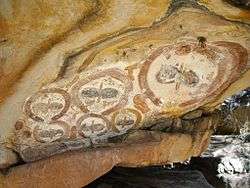Wandjina

The Wandjina (sometimes Wondjina) are cloud and rain spirits from Australian Aboriginal mythology that are depicted prominently in rock art in Australia. Some of the artwork in the Kimberley region of Western Australia dates back approximately 4000 years ago.
The stories of the Wandjina and the artwork depicting them remain important to the Mowanjum Community of Indigenous people.
Wandjina were the inspiration for a 1966 children's fantasy television series, Wandjina!, produced by ABC Television in 1966.
Dreamtime legends
Dreamtime stories say the Wandjina created the landscape and its inhabitants, and continue to have influence over both. When the spirits found the place they would die, they painted their images on cave walls and entered a nearby waterhole. These paintings were then refreshed by Aborigines.
The Wandjina can punish those who break the law with floods, lightning and cyclones.[1]
Traditional rock artwork
The broad-stroke artwork of the Wandjina rock art dates around 3800–4000 years ago. The emergence of this art style follows the end of a millennium long drought that gave way to a wetter climate characterised by regular monsoons.[2]
The Wandjina paintings have common colors of black, red and yellow on a white background. The spirits are depicted alone or in groups, vertically or horizontally depending on the dimensions of the rock, and are sometimes depicted with figures and objects like the Rainbow Serpent or yams. Common composition is with large upper bodies and heads that show eyes and nose, but typically no mouth. Two explanations have been given for this: they are so powerful they do not require speech and if they had mouths, the rain would never cease. Around the heads of Wandjina are lines or blocks of color, depicting lightning, clouds or rain.[1]
Today, the paintings are still believed to possess these powers and therefore are to be approached and treated respectfully. Each site and painting has a name. Indigenous people of the Mowanjum Community repaint the images to ensure the continuity of the Wandjina's presence.[3] Annual repainting in December or January also ensures the arrival of the monsoon rains, according to Mowanjum belief.[4]
Repainting has occurred so often that at one site the paint is over 40 layers deep. The painting style has evolved during this process: more recent figures are stockier and some now possess eyelashes.[5]
Other depictions
In 2007, graffiti depictions of Wandjina appeared in Perth, Western Australia. Styles ranged from stencil-work to a spray painted Wandjina driving a pink car. Using Flickr and blogs, several people engaged in 'Wandjina watching', documenting the Wandjina graffiti they found.[6] These 'wandering Wandjina' angered and upset some Indigenous people who said that only certain of their people are permitted to depict the Wandjina, without saying who these people are.[7] A short film, Who Paintin' Dis Wandjina, discussed the Aboriginal reaction.[8]
Images of the Wandjina are displayed on the walls of the Ringwood Magistrates Court in Victoria, these are referenced as produced the National Gallery of Victoria.
See also
References
- 1 2 Flood, Josephine (1997). Rock Art of the Dreamtime.
- ↑ McGown, Hamish; Marx, Samuel; Moss, Patrick; Hammond, Andrew (28 November 2012). "Evidence of ENSO mega-drought triggered collapse of prehistory Aboriginal society in northwest Australia". Geographical Research Letters. 39 (22): 5. doi:10.1029/2012GL053916.
- ↑ Flood, Josephine (1997). Rock Art of the Dreamtime.
- ↑ Akerman, Kim & Ryan, Judith (1993). Images of Power: Aboriginal Art of the Kimberley. p.12
- ↑ Mulvaney, John & Kamminga, Johan (1999). Prehistory of Australia. p.405
- ↑ perth.norg.com. au/2007/01/05/watching_the_wandjina/
- ↑ http://www.perthnow.com.au/news/western-australia/wandering-wandjinas-mystery/story-e6frg13u-1111112784667
- ↑ Spirits, Jens Korff, Creative. "Australian Aboriginal movies, films & Indigenous DVDs".